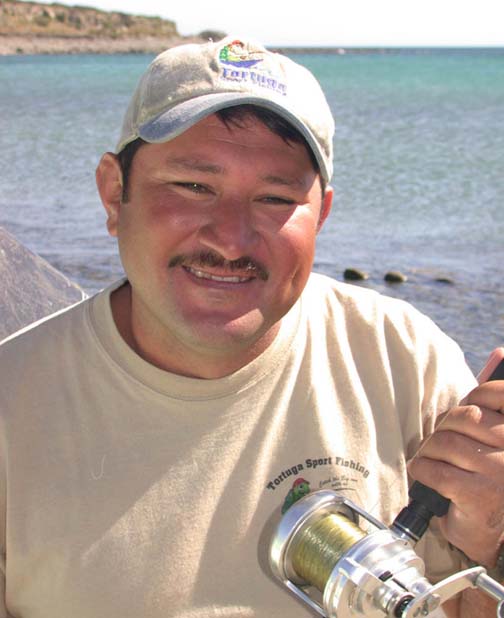
La Paz-Style Fishing Fun with Sardinas
![]()
|
SARDINA FUN--Tortuga Sportfishing’s Capt. Hugo Lucero at La Paz' Ensenada de los Muertos. Photo by Gene Kira. |
AN OFTEN-FRUSTRATING, ALWAYS ENTERTAINING FORM OF BAIT FISHING AT LA PAZ
By Gene Kira, February 16, 2004, as published in Western Outdoor News:
I’ll probably never really get the hang of Las Arenas-style sardina fly-lining as practiced in the fishing waters around La Paz, Baja Caiifornia Sur, Mexico, but there’s no doubting how much fun it is, even for a natural-born “ranchero.”
Last week, I got another exasperating lesson in this particular form of Baja fishing, this time from La Paz sportfishing Capt. Hugo Lucero Lucero, 27, who is one of the lead guides of La Paz’ Tortuga Sportfishing.
Gotta hand it to Hugo, he only laughed out loud three or four times.
|
|
Our panga was hunkering down, just outside La Paz' Ensenada de los Muertos, as a steady north wind made the waters out to Isla Cerralvo a bumpy herd of whitecap “bunnies mixed with sheep.”
Having given up early on thrashing our way up to Punta Arena or out to the island for roosterfish, we had scurried back behind the shelter of the point with a very nice load of live sardina baits which Hugo had netted in about five throws.
Around La Paz, fly-lining various “sardinas” is the preferred fishing method for many species, and will be pressed into service for just about all of them. Might as well call this place “La Sardina.”
Offshore, sardina are chummed and baited for dorado and tuna, and on the reefs, they are used on a generous range of good-eating snapper (“pargo”) types and leopard grouper (“cabrilla”), and--should you be so inclined--a fantastic array of miscellaneous fish such as chino mero, triggerfish, ladyfish, small cabrilla and groupers, graysbys, jacks, needlefish, a myriad of less common species, and of course, roosterfish, for which this area south of the city is world famous. (However, the preferred baits for roosterfish are actually slow-trolled ladyfish (“sabalo”), greenjack (“cocinero”), and mullet (“lisa”), in that order).
In our case, we had netted a bunch of the typical smaller sardina, or flatiron herring, just south of Punta Perico, and there we were, sitting on a shallow reef just outside Muertos, pinned in by the wind, with nowhere else to go.
|
|
Hugo tied a small bait hook on 30-pound line, pinned a sardina on, and threw it over the side. Following the local practice, he pulled about 10 brazas (maybe 60 feet) of line off my reel and threw it over the side in a heap as the wind began to push our panga away from my bait.
Quickly, Hugo grabbed a big handful of dead sardina and threw them right on top of the pile of line, followed by a steady chum of more sardina, tossed out a few at a time, as we slowly drifted back and the line straightened itself out.
Back, back we drifted, with me feeding more line into the water, so my bait wouldn’t be pulled out of the chum ball.
I kept my eyeballs fixed on the line like a homicidal maniac and swung like a TV bass pro every time it so much as twitched, but still managed to farm more than half of our hits--much to Hugo’s grand but restrained amusement.
There are a lot of fish here, and this method of catching them is very efficient, which I proved to myself by testing the action--and not getting any--with my benchmark casting jig, the Luhr Jensen stinger.
In comparison, our fly-lined sardina were getting hits within a minute on every drift, even if I did miss the majority of them, sometimes not even realizing it when my bait was picked off. (At these awkward moments, eagle-eyed Hugo would tactfully suggest that maybe I should check my line.)
Due more to the reef’s bountiful fish population than any discernible learning curve in the angler, we did manage a decent catch of leopard grouper and small snappers in about an hour of this comedy of errors. Thanks for the fishing lesson, Profesor Hugo, even if I did only get a B-minus, or maybe a C-plus? Fun!
|
LA PAZ BAIT--The common Baja Sur “sardina,” or flatiron herring, about five inches long. Photo by Eric Brictson. |
(Related La Paz articles and reports may be found at Mexfish.com's main La Paz information page. See weekly fishing news, photos, and reports from the major sportfishing vacation areas of Mexico including the La Paz area in "Mexico Fishing News.")
MEXICO FISHING INFO LA PAZ FISHING INFO "WEEKLY MEXICO FISHING NEWS" FISH PHOTO GALLERY

